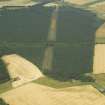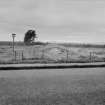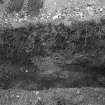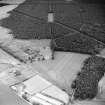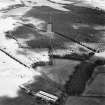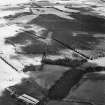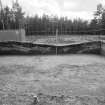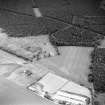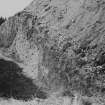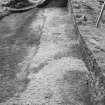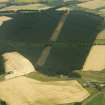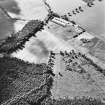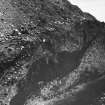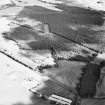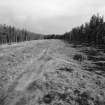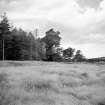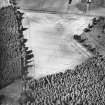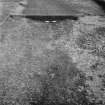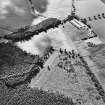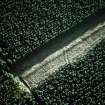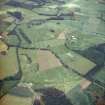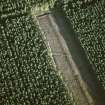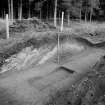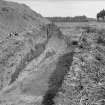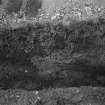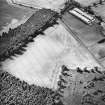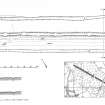Following the launch of trove.scot in February 2025 we are now planning the retiral of some of our webservices. Canmore will be switched off on 24th June 2025. Information about the closure can be found on the HES website: Retiral of HES web services | Historic Environment Scotland
Cleaven Dyke
Cursus (Neolithic)
Site Name Cleaven Dyke
Classification Cursus (Neolithic)
Alternative Name(s) Blairgowrie Road; Meikleour
Canmore ID 73146
Site Number NO14SE 80
NGR NO 1633 4049
NGR Description NO 1721 3998 to NO 1566 4088
Datum OSGB36 - NGR
Permalink http://canmore.org.uk/site/73146
- Council Perth And Kinross
- Parish Caputh
- Former Region Tayside
- Former District Perth And Kinross
- Former County Perthshire
NO 1566 4088 to NO 1715 3998 Cleaven Dyke, which appears to have no known parallel, is, in the opinion of Richmond (1940) and Sir Cyril Fox, a probable Roman frontier dyke with a political, rather than a military function.
The recognised remains extend to a distance of 2070yds, and consist of a large mound now about 30ft wide at the base and 5ft high, set equidistantly between two shallow, flat-bottomed ditches, 16ft wide and 2ft deep which lie 150ft apart from centre to centre (see Fig 2 in Richmond 1940).
Beyond the wood westwards there is no trace of the work, although St Joseph's CUCAP aerial photograph (GO65) shows the ditches about 200yds further in their direction. Eastwards from the wood the dyke can be seen in part as far as the Dunkeld - Coupar Angus road (A 984) where, at the 11th milestone, the mound passes through. From this point, in a SE direction, Stewart (Information from OS linear card RRX 519 held in OS linear record file MS 1178/30), quoting local information, states that the dyke can be traced in dry weather as far as the River Isla, and beyond to Little Keithock.
Information from OS (BRS) 12 April 1967.
I A Richmond 1940.
NO 1721 3998 to NO 1763 3973 S ditch shows as a belt of dark green grass (Information from OS linear card RRX 519 held in OS linear record file MS 1178/30).
NO 1763 3973 Mound passes through milestone (Information from OS linear card RRX 519 held in OS linear record file MS 1178/30).
NO 1763 3973 to NO 1927 3858 Farmers say that in dry weather the dyke can be traced in ploughed land to R. Isla and across towards Little Keithick (NO 1944 3872) (Information from OS linear card RRX 519 held in OS linear record file MS 1178/30).
Nothing is visible on the ground (WDJ).
NO 1763 3973 Streaks are visible to a certain distance in this field. Looked at from the air on 22 July 1930. Nothing is seen S or SE of road (Information from OS linear card RRX 519 held in OS linear record file MS 1178/30).
NO 1927 3858 A single green line seen of (?) Cleaven Dyke (Information from OS linear card RRX 519 held in OS linear record file MS 1178/30).
Information from OS (WDJ) 6 March 1969
The total length is 2,970yds. There is no other earthwork exactly like it, but it may be compared with the vallum parallel to Hadrian's Wall on the S, of which it is a sort of inversion and whose purpose may have been similar. Information from OS (ES) 21 Sept 1973.
O G S Crawford 1949.
NO 162 405. The Cleaven Dyke is a complex earthwork comprising a pair of parallel ditches (c.45m to 51m apart), with a central bank, running NW to SE for 1,820m through woodland. A further 350m or so is visible as a cropmark at the SE end. The central bank, which is between 1m and 2m high and about 9m broad, appears to consist of conjoined dumps and the ditch, where visible as a cropmark, appears to be made up of linked segments. At certain points (for example the NW terminal) it rises and broadens. There are at least two, and possibly a maximum of five, deliberately constructed breaks in the bank. In the NW portion (from the NW terminal to the main Perth-Blairgowrie road which cuts the monument) the Dyke is relatively straight and consistent in form. To the SE its line is far less constant. At a number of points either the central bank, for example the c.200m long section from the NW terminal to a major discontinuity in the bank, resembles a long barrow.
Small-scale excavation was undertaken at three points on the Cleaven Dyke. At the SE end narrow trenches were dug to look for the end of the Dyke, or at least the point beyond which the ditches did not survive. This was successful.
Also within the cropmark section (NO13NE 89) a larger area, measuring 9m by 30m was excavated over the southern ditch. Two lengths of the ditch were excavated in plan. It was revealed as very broad, shallow and irregular.
Some 1300m to the NW a 3m-wide section was cut through the central bank at a point where it had already been damaged by quarrying. The excavation was taken down to and then through the old land surface and B-horizon. Pits located within and beneath the old land surface were excavated. Briefly, the bank sections revealed an off-axis (to the NE) primary dump made up of (?) turf and mixed material, probably the fill of the northern ditch. Over this dump on the SW side was a layer possibly of turf (either turf dump or an old land surface). Over this layer further sands and gravels, probably the fill of the southern ditch. At both sides of the bank was a small primary dump of (?) turf apparently toeing the gravel of the bank. F005 appeared as a shallow hollow within the old land surface, cut by the section. It contained large pieces of charcoal which may have been burned in situ.
The section through the bank was continued as a 1m-wide trench across the berm to an across the N ditch, which was revealed to be c.5m wide and 1m deep below the modern topsoil surface.
The Cleaven Dyke closely resembles the structure at Scorton in Yorkshire, which has been identified as a cursus monument. It is suggested that both monuments combine the features of the monument type termed 'bank barrow' and the features of a cursus monument. A 'typical' bank barrow would have its quarry ditches immediately beside the mound, not about 19m away. The c.47m-broad, 2100m long enclosure formed by the ditches is typical of a cursus monument. Both types of monument are thought to belong to the first half of the third millenium BC.
Sponsors: Society of Antiquaries of London, Society of Antiquaries of Scotland, Prehistoric Society
G J Barclay and G S Maxwell 1993
NO14SE 80 1721 3998 to 1566 4088. LIN 1
Extends onto map sheet NO13NE: see also NO13NE 89 (SE end of cursus).
Formerly entered as RRX 519.
See Summary Record LIN 1 and NO13NE 89 (SE end of cursus).
Scheduled [with NO13NE 89] as 'The Cleaven Dyke, cursus and bank barrow... a linear monument of Neolithic date... [which] combines the characteristics of a cursus monument and a bank barrow.'
Information from Historic Scotland, scheduling document dated 12 August 2005.
NO13NE 89 from 1721 3998 to 1755 3979. LIN 1
Extends onto map sheet NO14SE: see also NO14SE 80 (NW end of cursus).
Formerly entered as RRX 519.
For archive relating to excavations of 1939 (Richmond) and 1986 (Adamson and Gallagher), see under NO14SE 80.
Radiocarbon dating of samples recovered during the 1993 excavations indicate a Neolithic monument, dating to before 3600 BC.
L J F Keppie 1996.
NO 162 405 The contour survey of the entire length of the Cleaven Dyke was completed. The dyke is a complex Neolithic earthwork comprising a pair of parallel ditches (c 45-51m apart), with a central bank, running NW-SE for 1820m through woodland. The results of the survey will allow the first detailed analysis of the monument.
Sponsors: Historic Scotland, Society of Antiquaries of Scotland, British Academy, Russell Trust, Society of Antiquaries of London.
C Burgess, G J Barclay and G S Maxwell 1996.
Scheduled [with NO14SE 80] as 'The Cleaven Dyke, cursus and bank barrow... a linear monument of Neolithic date... [which] combines the characteristics of a cursus moinument and a bank barrow.'
Information from Historic Scotland, scheduling document dated 12 August 2005.
Field Visit (12 March 1969)
NO 1513 4102 to NO 1763 3973 Generally as described above. There is no trace either on aerial photographs or on the ground, S of the A 984. The features are considerably mutilated and obscured by a dense fir plantation and undergrowth in North and South Wood. Resurveyed at 1:2500 (see also NO14SE 80).
Information from OS (RD) 12 March 1969.
Publication Account (13 November 1974)
A Roman boundary guarded by a watch tower. It does not extend far enough to mark an actual frontier and probably defined the territorium of the legion based at Inchtuthil - provision area under strict military control.
Information from OS (DC) 13 Nov 1974.
S Frere 1974.
Excavation (March 1975)
In March 1975 an excavation of a section of the Cleaven Dyke was carried out by H C Adamson on behalf of the Department of the Environment, in advance of the construction of the St Fergus to Bathgate section of the British Gas pipeline.
(formerly also recorded as Event ID: 552562)
Field Visit (13 November 1975)
(NO13NE 89) No change in previous field report.
Information from OS (NKB) 13 Nov 1975.
Measured Survey (1991)
In advance of clear-felling and as part of the fieldwork for the RCAHMS SE Perth publication, a section of the Cleaven Dyke measuring 252m in length from WNW to ESE was surveyed by plane-table at a scale of 1:500. The survey was undertaken in 1991 by John Sherriff, archaeologist, and Alan Leith, surveyor.
Field Visit (June 1992)
The Cleaven Dyke is aligned NW-SE and extends for a distance of about 2.3km across level ground to the N of the confluence of the Rivers Tay and Isla. Upstanding traces survive in woodland for about 1.73km (NO 1566 4087 to 1721 3997), the remainder now being known from soil-and cropmarks. There is no evidence that it originally extended as far to the SE as the probable square barrow at Hallhole (NO13NE 10) that is shown on the early maps of Stobie and McOmie or implied by Pennant, nor that it extended beyond the present NW terminal.
The Dyke is neither straight nor totally regular, but displays minor changes of alignment at several points along its course, and is interrupted by an original gap at NO 1705 4007. The gap through which the A93 road passes (NO 168 402) may also be of early origin, while the thickening of the bank at the NW end of the upstanding section may mark the SE side of a further gap.
The Dyke comprises a bank flanked on each side by a broad berm and a single ditch. The bank measures between 8m and 10m in thickness for most of its length, and up to about 1.8m high, but is appreciably larger at its NW terminal, where it is some 16m thick. In the light of sections cut in 1993, earlier records (J Abercromby 1902; I A Richmond 1940; H Adamson and D Gallagher 1986) of its structure and composition appear to be misleading.
The ditches are set between 8 and 9m from the bank and appear to be of varying widths, particularly in the SE portion, as revealed by cropmarks. They were perhaps dug in sections and were in places up to 6.5m broad.
To the W of the A93 (where the undergrowth is less dense than elsewhere along the Dyke) there are traces of rig-and-furrow cultivation between the bank and the ditches. The ridges are most clearly visible to the S of the bank and are of two phases, the earlier aligned roughly at right-angles to the bank and in places overriding it, while the rigs of the later phase run parallel to the bank. Traces of various trackways and field-banks can also be seen cutting across the crown of the Dyke. There is no direct evidence for the date of the Dyke, but study of the soils and pollen from the most recent section suggests that it was constructed in land that had already seen one or more phases of clearance and cultivation. Due to its apparent straightness and regularity, and its proximity to the Roman fortress at Inchtuthil (NO13NW 5.00) the Dyke was formerly considered to be a Roman defensive work (T Pennant 1776) or political boundary (I A Richmond 1940), but better analogies may be found among Neolithic cursuses.
Visited by RCAHMS (AW/SH) June 1992.
T Pennant 1776; J Stobie 1783; J McOmie 1784; J Abercromby 1902; I A Richmond 1940; L F Pitts and J K St Joseph 1985; H Adamson and D Gallagher 1986; G S Maxwell 1989.
Excavation (4 September 1993 - 7 June 1995)
Four trenches cut through the line of the Cleaven Dyke.
NO 162 405. The Cleaven Dyke is a complex earthwork comprising a pair of parallel ditches (c.45m to 51m apart), with a central bank, running NW to SE for 1,820m through woodland. A further 350m or so is visible as a cropmark at the SE end. The central bank, which is between 1m and 2m high and about 9m broad, appears to consist of conjoined dumps and the ditch, where visible as a cropmark, appears to be made up of linked segments. At certain points (for example the NW terminal) it rises and broadens. There are at least two, and possibly a maximum of five, deliberately constructed breaks in the bank. In the NW portion (from the NW reminal to the main Perth-Blairgowrie road which cuts the monument) the Dyke is relatively straight and consistent in form. To the SE its line is far less constant. At a number of points either the central bank, for example the c.200m long section from the NW terminal to a major discontinuity in the bank, resembles a long barrow.
Small-scale excavation was undertaken at three points on the Cleaven Dyke. At the SE end narrow trenches were dug to look for the end of the Dyke, or at least the point beyond which the ditches did not survive. This was successful.
Also within the cropmark section (NO13NE 89) a larger area, measuring 9m by 30m was excavated over the southern ditch. Two lengths of the ditch were excavated in plan. It was revealed as very broad, shallow and irregular.
Some 1300m to the NW a 3m-wide section was cut through the central bank at a point where it had already been damaged by quarrying. The excavation was taken down to and then through the old land surface and B-horizon. Pits located within and beneath the old land surface were excavated. Briefly, the bank sections revealed an off-axis (to the NE) primary dump made up of (?) turf and mixed material, probably the fill of the northern ditch. Over this dump on the SW side was a layer possibly of turf (either turf dump or an old land surface). Over this layer further sands and gravels, probably the fill of the southern ditch. At both sides of the bank was a small primary dump of (?) turf apparently toeing the gravel of the bank. F005 appeared as a shallow hollow within the old land surface, cut by the section. It contained large pieces of charcoal which may have been burned in situ.
The section through the bank was continued as a 1m-wide trench across the berm to an across the N ditch, which was revealed to be c.5m wide and 1m deep below the modern topsoil surface.
The Cleaven Dyke closely resembles the structure at Scorton in Yorkshire, which has been identified as a cursus monument. It is suggested that both monuments combine the features of the monument type termed 'bank barrow' and the features of a cursus monument. A 'typical' bank barrow would have its quarry ditches immediately beside the mound, not about 19m away. The c.47m-broad, 2100m long enclosure formed by the ditches is typical of a cursus monument. Both types of monument are thought to belong to the first half of the third millenium BC.
Sponsors: Society of Antiquaries of London, Society of Antiquaries of Scotland, Prehistoric Society
G J Barclay and G S Maxwell 1993
NO 162 405. The Cleaven Dyke is a complex earthwork comprising a pair of parallel ditches (c.45m to 51m apart), with a central bank, running NW to SE for 1820m through woodland. A further 350m or so is visible as a cropmark (NO13NE 89) at the SE end. The central bank which is between 1m and 2m high and about 9m broad, appears to consist of conjoined dumps, and the ditch, where visible as a cropmark, appears to be made up of linked segments. Radiocarbon dating of samples from the first (1993) season has shown that the Dyke is a Neolithic monument, dating to before 3600BC (Barclay et al 1995).
A trench was opened immediately to the SE of the cross-section of the bank opened in 1993. It was an axial section along the bank designed to examine one of the apparent boundaries between two dumps. One of the characteristics of the bank is a lateral 'toe' of turf holding the gravel of the bank in place on each side. Richmond (Richmond 1940) demonstrated that at one of the constructed breaks in the bank the 'toeing' continued round the end of the bank segment. The 1995 section also showed that the NW of the two dumps was finished off at its SE end in the same way, the dump to the SE then being added. It seems likely therefore that the bank was constructed in segments.
On the old land surface there were few features. The most interesting was a shallow pit, the contents of which formed a low gravel mound immediately beside it. It is possible that this was one of a series of markers on the line of the bank.
Sponsors: British Academy, Russel trust, Society of Antiquaries of Scotland, Society of Antiquaries of London, Prehistoric Society, Historic Scotland.
G J Barclay and G S Maxwell 1995.
Project (1993 - 1996)
Excavations, detailed contour survey and geophysics at Cleaven Dyke and Littleour.
Contour Survey (1994 - 1997)
A survey of the Cleaven Dyke was carried out over five seasons between 1994 and 1997. The survey comprised creating a Digital Terrain Model complemented by mapping the key topographic features (top of bank, bottom of bank etc).
Chris Burgess 1998, 74-77
Earth Resistance Survey (November 1995 - 1996)
Electrical resistivity profile surveys using the Wenner Array at the north-wets terminal and over south-eastern cropmark portion of the Cleaven Dyke.
Change Of Classification (1996)
This monument was formerly classified as a Roman EARTHWORK but has subsequently been reinterpreted as a Neolithic CURSUS.

































